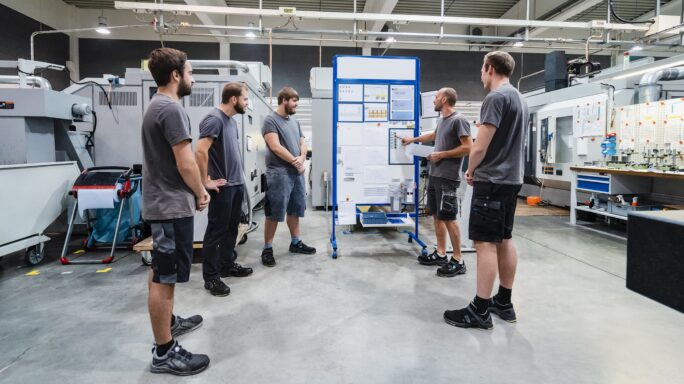Cloud adoption: Why you should work on supporting your employees first
Learn why it's vital for your manufacturing firm to include your employees in your cloud adoption journey along every step of the way.

Manufacturers can save time, effort and money through cloud adoption projects.
Some of the benefits of cloud computing include improved productivity, accessibility, reporting and data security, as well as lower operating and IT costs.
However, if you’re looking at cloud adoption for your manufacturing firm, it’s really important that your people are a key part of the process.
Rather than implementing the changes then informing your employees, they should be involved from the start.
Read this article to find out why your employees should play a role during every step of your cloud journey, how to support them, and how to avoid potential pitfalls within your team.
After all, you don’t want to get this wrong and pay a hefty price for delays or even lose key people.
Here’s what we cover:
Why manufacturers should put people first in cloud adoption projects
How and why businesses think about tech first and people last
Five common pitfalls for manufacturers going through cloud adoption projects
Why you should put people and culture first
Four top tips for a successful cloud adoption project
Final thoughts on supporting your people in cloud adoption projects
Why manufacturers should put people first in cloud adoption projects
Guy Sorrill is director of consulting at Sysdoc, which provides teams of experts to support business and technology change projects, including within the manufacturing sector.
He says medium-sized manufacturers can add 10% to the cost of a technology change project – equating to thousands or millions of euros – by racing ahead without first getting support from their employees.
He adds: “You can put any technology in the cloud or on someone’s computer, but if they don’t see the value of using it, or how it will improve their work, you may struggle to realise the benefit of your investment.”
How and why businesses think about tech first and people last
Shifting to cloud technologies can represent a significant organisational change, involving multiple teams or departments.
It may also be viewed as a minor threat by some employees, who may have been working in the same way, unchallenged, for years.
A key risk occurs when some manufacturers overlook these concerns and potential impacts on people’s jobs. Business owners are so keen to realise savings, that they decide to make changes, and wait to see how their people receive it, says Sorrill.
In an attempt to save money, some manufacturers also fail to put in place a clear change management plan, which can prove to be a false economy on strategic projects.
But the impact of moving to the cloud without involving your people could be a negative one.
People are the lifeblood of your business and happy staff have been found to be 12% more productive. If you lose the trust of your employees, and they vote with their feet, you may soon find that recruitment and retraining costs become significant.
Five common pitfalls for manufacturers going through cloud adoption projects
1. Lack of leadership support
As the leader of a manufacturing business, one of the biggest mistakes you can make in a tech project is to fail to lend your personal support, or that of your management team.
Lead by example, and champion the project to your employees – otherwise they won’t support a potentially disruptive change.
2. Unclear vision
You must ensure that any cloud technology solution meets a clear business need.
Technology is an enabler, but it’s rarely ever a ‘magic bullet’, and without care, you could end up with responsibility and accountability for a wasteful and ineffective project.
3. Lack of planning
Shifting to the cloud may result in changes to the processes and organisational structure of your business.
Plan ahead in order to manage these sensitive aspects and maintain morale, and keep the project on time and budget.
4. Failure to involve your people
If you fail to explain changes to your employees or involve them in the process, you may find some become opposed to the project ‘on principle’ and fail to co-operate, which can seriously hamper progress and results.
5. Lack of investment in change management
Change management is widely adopted by large manufacturers, but some smaller firms still view it as ‘fluffy’, and not business critical.
According to Sorrill, the less manufacturers spend on managing change, the more likely it is that cloud transformation projects will fail.
Why you should put people and culture first
Failing to engage your people can have serious impacts on your bottom line.
Sorrill says one firm had approached him for support after failing to engage its leadership, or implement change management. This approach caused big resistance among employees, and an 18-month extension to the technology roll-out.
That’s 18 months of additional spend, and 18 months of unrealised cost savings.
This misguided approach added 10% to the overall cost of programme, and put leaders on the back foot, resulting in lost confidence from their people.
Four top tips for a successful cloud adoption project
1. Create a clear vision and plan
Get support for the project from your senior managers at the start of the project to help with engaging the whole workforce.
2. Communicate with your people
You need to explain to all your people, as early as possible, why the change is necessary, the benefits of the project and how you plan to reach the destination.
Create an open and transparent culture where people are happy to ask questions, share concerns and suggest improvements on changes that could affect their jobs and day-to-day working.
3. Prioritise training
Consider creating an online course to train people on how to use your new tech.
This approach will allow people to learn at their own pace and avoid the fatigue and logistical challenges associated with classroom-based learning. If possible, you can tailor the training to the needs of different teams within your business for best results.
However, if you find in-person training is the best approach for your business, take that route (or perhaps a combination of the two).
And make sure training is an ongoing process, not a one-off exercise.
4. Consider getting support
Your strength is in running a manufacturing company – not delivering tech change projects.
It may be worth considering getting additional support to ensure long-term success.
This could include getting the right capability in-house, upskilling your people, and ensuring change is continually managed.
Final thoughts on supporting your people in cloud adoption projects
Irish manufacturing businesses have just been through one of the biggest-ever changes to operations, due to the pandemic. Now, as the price of materials increases due to disruptions, many are renewing their focus on reducing operating costs.
It’s a great time for forward-thinking manufacturers to get ahead using cloud technologies.
Just make sure that your business has a clear plan, and safeguards in place to avoid potential pitfalls. And ensure your people are involved along every step of the way.






Ask the author a question or share your advice